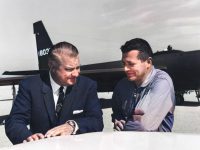
Alexandre Darracq (1855-1931)
On November 10, 1855, French investor, engineer, cycle manufacturer and automobile manufacturer Alexandre Darracq was born. By 1904, Darracq was producing more than ten percent of all automobiles in France. Producing 1600 vehicles, he was even the most successful car manufacturer in the world.
Alexandre Darracq – From Sewing Machines to Automobiles
Born Pierre Alexandre Darracq in Bordeaux, France, of Basque parents, he trained as a draftsman at the Arsenal in Tarbes, in the Hautes-Pyrénées département. He later worked at the Hurtu factory manufacturing sewing machines, and Darracq designed a machine that won a gold medal at the 1889 Paris exhibition. He established the Gladiator Cycle Company in 1891. His bicycles were reputed to be reliable but also very affordable.[2] He sold his very successful company in 1896 for a substantial amount and for a short time went into the business of manufacturing electric cars as well as acquiring an interest in rotary engined Millet motorcycles.
He liked neither to drive nor to be driven
He established Automobiles Darracq France in Suresnes, near Paris where he pioneered the making of the chassis from pressed steel and the use of production machinery in place of hand labor. Despite his establishing an automobile business, and having taken driving lessons in July 1896, Darracq did not like driving cars or even being driven in them. For him, it was just pursuing his interest in manufacturing and making money. Darracq’s first effort in large-quantity production of automobiles occurred in 1898, when he began building Léon Bollée voiturettes under license.[1] With the purchase of Léon Bollée’s patents the company also built and exhibited at the 1896 Paris Salon an electric powered carriage under the brand name PREFECTA and in 1897 built a tricycle said to reach speeds of up to 60 km per hour.[2]

Alexandre Darracq in 1897, Collection Jules Beau. Photographie sportiv
Going International
With a sound reputation carrying on from the previous year, M. Darracq signed a license contract with Adam Opel to produce cars in Germany under the name Opel-Darracq.[2] The Darracq Flying Fifteen of 1904 was a production model of exceptional quality. By 1904, Darracq was producing more than ten percent of all automobiles in France. His company became involved with motor racing, winning a number of major races, including the 1905 and 1906 Vanderbilt Cup in the United States and twice setting a new land speed record in 1904 and 1905; a V-8 racing Darracq with a claimed 200 hp, by the time by far the most powerful racing car in the world, was timed at 197.06 km per hour in 1906.[1] Racing success raised the image of the Darracq marque so he was able to expand to England and form licensing partnerships.
![By Tim Frost from Braintree, England (Regent Street Motor Show, 2015) [CC BY-SA 2.0 (http://creativecommons.org/licenses/by-sa/2.0)], via Wikimedia Commons](http://scihi.org/wp-content/uploads/2016/11/1901_Darracq_6.5_HP_two-seater_23718792730_cropped-600x533.jpg)
A 1901 Darracq 6.5 hp Two Seater, By Tim Frost from Braintree, England (Regent Street Motor Show, 2015) [CC BY-SA 2.0 (http://creativecommons.org/licenses/by-sa/2.0)], via Wikimedia Commons
Alfa Romeo and Talbot-Sunbeam
In 1904 Darracq sold his business to British investors who incorporated A Darracq and Co in which he held a substantial shareholding and was a director. He remained manager of the enterprise. Darracq raised substantial capital through share issues in Italy with Cavaliere Ugo Stella, in Germany with Adam Opel as well as in Vitoria, in the Basque region of Spain. The company that became Alfa Romeo was founded as Società Anonima Italiana Darracq (SAID) in 1906. Darracq’s organization, which merged with Talbot–Sunbeam in 1920 and was dissolved in 1952, produced automobiles under the trademarks Darracq, Talbot–Darracq, and Talbot.[1]
Retirement
After personally insisting the new 1911 model employ the Henriod rotary valve engine, Alexadre Darracq resigned.[1] In 1913, he sold out to British investors and pursued other interests including running the Casino at Deauville. After World War I, he chose to retire to the French Riviera where he invested with the Belgian interests that took over the troubled luxury Hotel Negresco in Nice. He died in 1931 in his Monegasque home and was buried with his wife Louise (1850-1920) in the family mausoleum, sculpted by Paul Landowski, at the Père-Lachaise cemetery in Paris (division 2).
TEDx Brussels 2010 – Sebastian Thrun – Rethinking the Automobile, [4]
References and Further Reading:
- [1] Alexandre Darracq, French manufacturer, at Britannica Online
- [2] Ivan Pozega: The Fire-Breathing 1905 Darracq 200 HP Land Speed Record Car, at The Old Motor
- [3] Alexandre Darracq at Wikidata
- [4] TEDx Brussels 2010 – Sebastian Thrun – Rethinking the Automobile, TEDx Talks @ youtube
- [5] Wise, David Burgess (1974). “A Motor Enthusiast Who Hated Driving”. The World of Automobiles. Vol. 5. Orbis Publishing. pp. 493–494
- [6] Timeline of Automotive Pioneers, via DBpedia and Wikidata





